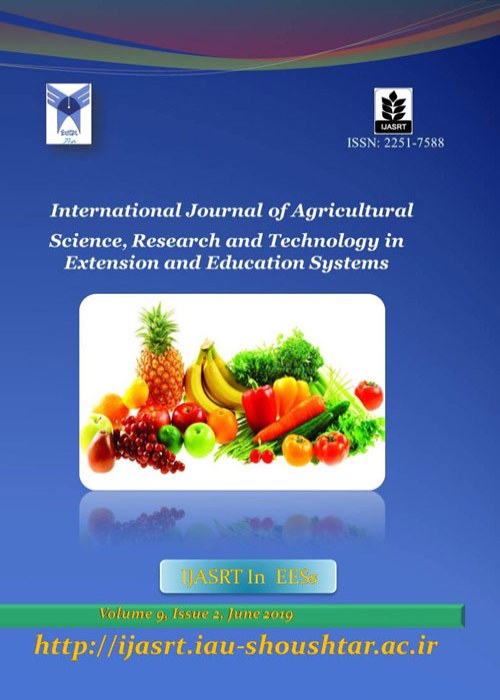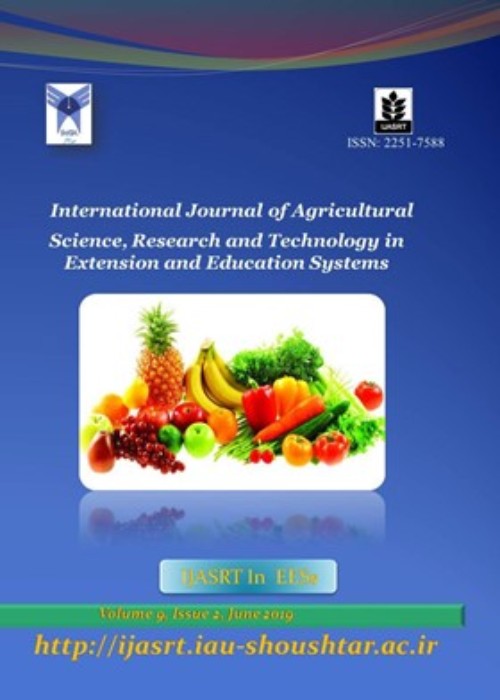فهرست مطالب

International Journal of Agricultural Science Research and Technology in Extension and Education Systems
Volume:12 Issue: 4, Dec 2022
- تاریخ انتشار: 1402/01/08
- تعداد عناوین: 6
-
Pages 179-188The study investigated the adoption level of organic farming practices among fluted pumpkin vegetable farmers in Enugu state, Nigeria. Multistage sampling procedure was used to select 84 fluted pumpkin farmers, and data was collected through structured questionnaires. Data were analyzed using SPSS software and presented in mean, percentages and frequency distributions. Findings indicated that majority (65.5%) of fluted pumpkin farmers regularly acquire information about organic practices through fellow farmers. Approximately 70.2% and 61.9% of the respondents noted that the use of animal manure and farmyard manure were the organic farming practices mostly disseminated in the zone. Among the different organic farming practices examined, only the use of animal manure (M=3.94; SD=1.302) was adopted. Poor storage of organic material (M=3.01; SD=0.768), low yield (M=2.76; SD=1.082), little/no policy (M= 2.74), inadequate information (M=2.70) among others, were the major challenges militating against the adoption of organic farming practices among farmers. Results also revealed that promoting government policy that supports organic farming (M=1.58; SD=.564), increasing extension service deliveries on organic farming (M=1.55; SD=.589) and establishing organic producing companies to supply adequate inputs (M=1.48) among others, were the major strategies suggested by farmers that will help in improving the adoption of organic farming on vegetable production. Therefore, government, through the ministry of agriculture, should train extension agents on organic farming practices to enable them have required capability to enlighten fluted pumpkin and other vegetables farmers. Also, government should bring up policies that would promote production, marketing and consumption of organically produced vegetables.Keywords: adoption, Organic, manure, Information, crop production
-
Pages 189-202
The purpose of this paper is to identify mass media channels accessed by farmers and analyse how they are used to communicate agricultural information in the Wolaita Zone, Southern Ethiopia. This study involved a proportionate sample of 364 farm households that were selected using a systematic random sampling technique. A pre-tested semi-structured interview schedule was administered to collect primary data during June and July of 2020. Descriptive statistics and bivariate analysis were employed for the analysis. Three focus group discussions with progressive farmers were held, and the data obtained was thematically analysed. The results indicated that mobile phones, radio, television, and print media were accessed by farmers to receive agricultural information. However, mass media methods have not been extensively used by farmers for agricultural knowledge and information sharing. The study found low ownership of media devices, lack of communication infrastructure, low coverage of agricultural programmes, and high levels of illiteracy were attributed to low access and usage of mass media. To improve this, the study issued recommendations for the government and development organizations to improve rural communication. Mass media should be encouraged to increase the number of agricultural programmes they broadcast and make them more suitable for local contexts.
Keywords: Mass Media, Information, Channel, Communication, development -
Pages 203-214The study looked at the effect of FADAMA III program on food crop production among rural women farmers in Akoko South-West Local.Government area of Ondo State, Nigeria. A structured questionnaire was used to collect data from 120 respondents, including sixty(60) participating and sixty(60) non-participating rural women farmers. The study data were analyzed using descriptive statistics, net farm income models, logit regression models, and Ordinary Least Square regression (OLS). The study found that participating and non-participating rural women farmers had mean ages of 46 and 49 years, respectively, and had completed secondary education. At 1% and 5% levels of likelihood, age, farm size, times of extension visit, and farming experience were all significant in the logistic regression results. FADAMA III participants and non-participants had net farm income (NFI) of ₦189,691.82 /Ha and ₦108,417.73 /Ha, respectively. The cost-benefit ratios for participants and non-participants were 12.82 and 8.40, respectively. According to the OLS regression, farm size (2515.581) is the only variable that is significant at 5% for non-participants, although educational status (59846.796) and farming experience (167547.42) are significant at 1% and 5% for participants as factors determining their net income. Inadequate extension agent output, poor leadership, a negative attitude toward the program, and a lack of knowledge of the program were the major constraints. The study revealed that Agricultural programs such as FADAMA III programs and other empowerment programs are essential to the agricultural sector, most especially the rural dwellers in most of the developing countries.Keywords: Fadama III, Food crops, program
-
Pages 215-224Despite many decades of intensive research by universities and other research centers in the public and private sectors that could improve finance and monetary applications in agriculture activities, there has as yet not been any brilliant transforming commercialization. as the objective, Commercialization barriers causing slow market growth and poor acceptance of agriculture research in Iran are discussed here. The study's population consists of Qom Keshavarzi Bank employees. The sampling method is proportional classification, and a questionnaire is a research tool. The validity of the questionnaire was confirmed by the ideas of the specialists’ panel while its reliability was supported by using Cronbach’s alpha ratio with an internal correlation coefficient of 0/79. Descriptive and deductive methods were used to analyze information. SPSS and LISREL software packages were used for statistical analyses. Findings indicate that the research theoretical model on the direct and negative impact of such challenges as lack of knowledge on commercialization, policy making, lack of organs that support commercialization, commercialization negligence, and research structure on latent variable of agricultural research findings is confirmed by high fitness which indicates right identification of affecting challenges on research commercialization and needs to find solution for facilitating the modification of such challenges.Keywords: Challenge recognition, Commercialization, Agricultural researches
-
Pages 225-233
Post-Harvest Losses are fast becoming a major problem causing huge losses for farmers and various countries at large. This challenge has resulted in various attempts to reduce the losses as much as possible. Crop production is essential to life sustenance, hence post-harvest losses are undesirable as it results in a threat to life and a reduction in income for Farmers. This study reviews post-harvest losses, especially in developing countries that are mostly affected by the supply chain, post-harvest losses in vegetables, fruits, and cereals have also been studied. Measures and technologies that can be adapted to reduce post-harvest losses have been discussed in this study with the sole aim of ensuring a reduction in such losses. It is believed that when these various measures as discussed herein are applied, the incidence of post-harvest losses would be drastically reduced. This reduction could result in a wider profit margin for the masses.
Keywords: Crop, farmers, losses, Post-harvest, Technology -
Pages 235-248The work assessed the production characteristics of cocoyam farmers in Enugu State, Nigeria. Questionnaire was used to elicit relevant information from a sample of 80 randomly selected respondents. Frequency, percentage and mean were used for analysis. The mean household size was 6 with the mean farming experience of 24.0 years. 47.5% had mean farm size of 2.3 hectares with average annual income of N30543.8. Production practices utilized by cocoyam farmers are use of organic fertilizer (X=2.74) and use of manual labour in land preparation (X= 2.99). The information sources of farmers are friends (X=2.26), neighbour (X=2.46), co-farmers (X=2.46). Information needs of farmers were sourcing of farm inputs (X=3.88), sourcing of improved farm tools (X= 2.84) among others. Production constraints were incidences of pests and diseases (X=3.68), lack of extension contact (X=2.98) among others while ways of improving production are use of disease resistant varieties (X=2.95), formation of farmers` cooperative societies (X=2.44), among others. The study recommended among others that research institutes, federal and state government should in partnership, develop weed, pest and disease resistant cocoyam varieties, subsidized farm inputs, and provide extension services to cocoyam farmers.Keywords: farmers, cocoyam, varieties, production, practices


